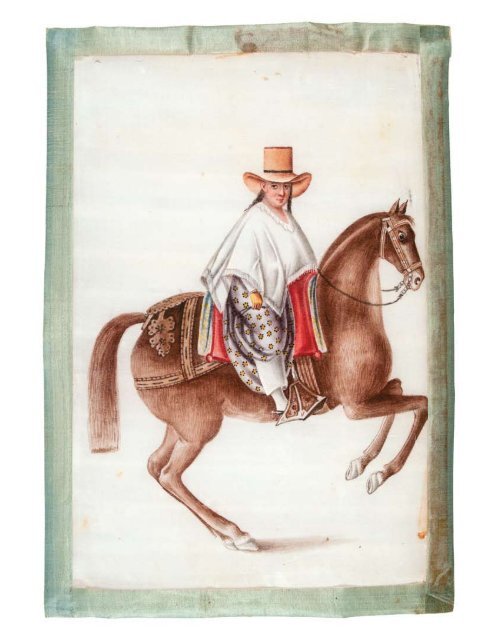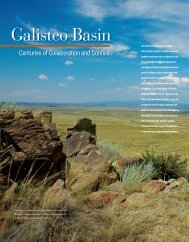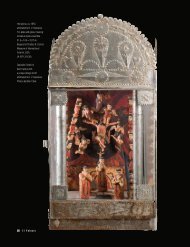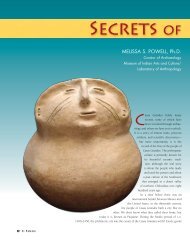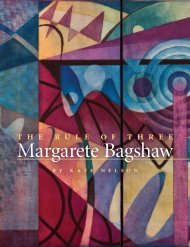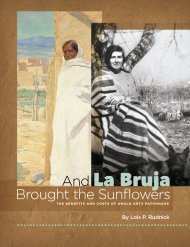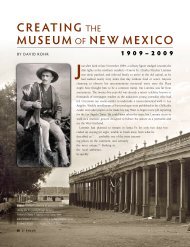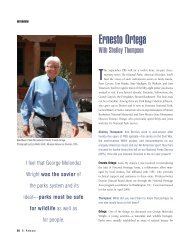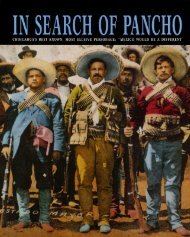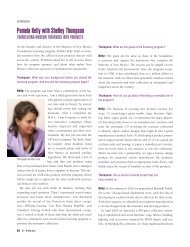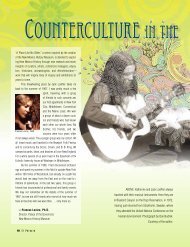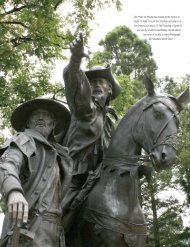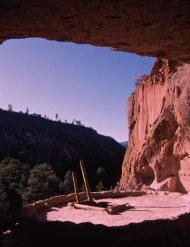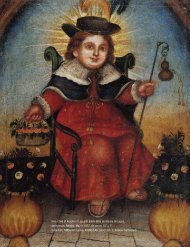From Lima to Canton and Back: Nineteenth-Century Watercolors for ...
From Lima to Canton and Back: Nineteenth-Century Watercolors for ...
From Lima to Canton and Back: Nineteenth-Century Watercolors for ...
Create successful ePaper yourself
Turn your PDF publications into a flip-book with our unique Google optimized e-Paper software.
from lima<strong>to</strong> can<strong>to</strong>n& back<strong>Nineteenth</strong>-<strong>Century</strong>by barbara <strong>and</strong>ersonChinese <strong>Watercolors</strong><strong>for</strong> Perupho<strong>to</strong>graphs by blair clarkIn 2003 the Museum of International Folk Art was given eleven watercolors on pale, fragilepaper with blue silk borders. The donors, Maurine <strong>and</strong> Frank Iklé of Albuquerque, inheritedthe set in the 1940s from Mr. Iklé’s gr<strong>and</strong>father, a Swiss collec<strong>to</strong>r who, the Iklés believed, hadpurchased it in Spain.Each sheet depicts a street vendor or other denizen of nineteenth-century <strong>Lima</strong>, Peru, wearingtypical costume <strong>and</strong> representing various classes <strong>and</strong> ethnic types, or tipos, of that vibrantcity, then in the throes of all the exhilarations <strong>and</strong> travails of a capital of a newly independentnation. All were executed in a style similar <strong>to</strong> that of Francisco Fierro (<strong>Lima</strong>, ca. 1808 – 1879), aniconic mulat<strong>to</strong> artist who worked in <strong>Lima</strong> <strong>for</strong> much of the nineteenth century. Fierro producedthous<strong>and</strong>s of images of typical limeños <strong>and</strong> their cus<strong>to</strong>ms <strong>for</strong> the many Europeans <strong>and</strong> NorthAmericans allowed in Peru <strong>for</strong> the first time after the restrictive Spanish monarchy, <strong>to</strong> invest in<strong>and</strong> construct railroads, mines, <strong>and</strong> other public works projects.The lively <strong>and</strong> detailed figures belong <strong>to</strong> the genre known as costumbrismo, the artistic representationof common regional types, a category that flourished in Europe, China, <strong>and</strong> Latin Americain the nineteenth century, satisfying a thirst <strong>for</strong> knowledge of exotic folkways. The costumbrismogenre became a favored subject of painting <strong>and</strong> literature around the world, especially in Spain,where the denizens of various cities <strong>and</strong> provinces were the subject of encyclopedias, such asFrancisco Pradilla y Ortiz’s Las mujeres españolas, portugesas y americanas (Madrid, 1872), <strong>and</strong>novels in<strong>to</strong> the twentieth century, <strong>for</strong> example, Miguel de Unamuno’s De mi país of 1903. In Peru,as elsewhere in the Americas, it was an integral part of the construction of collective identitiesbeginning with the earliest accounts by colonizers in the sixteenth century <strong>and</strong> continuingunabated through the mid-nineteenth. Over time, the st<strong>and</strong>ard visual <strong>for</strong>mat <strong>for</strong> these representationsevolved <strong>to</strong> concentrate mainly on single sheets of figures rendered in watercolor on a starkwhite ground. Later, in the 1860s, pho<strong>to</strong>graphic versions of costumbrismo paintings <strong>and</strong> printsalso began <strong>to</strong> circulate, eventually eclipsing in popularity these h<strong>and</strong>made one-off watercolors<strong>and</strong> the prints made after them.The most important recent contributions <strong>to</strong> our underst<strong>and</strong>ing of this genre as it developedin Peru have been made by Natalia Majluf, direc<strong>to</strong>r of the Museo de Arte de <strong>Lima</strong>, particularlyin a groundbreaking exhibition held in 2006 at the Americas Society in New York, entitledReproducing Nations: Types <strong>and</strong> Costume in Asia <strong>and</strong> Latin America ca. 1800 – 1860. In her twocatalogue essays, Majluf charts the evolution of the <strong>for</strong>m from its beginnings with the lateeighteenth-century scientific illustra<strong>to</strong>rs who specialized in watercolor depictions of theOpposite: Woman in WhitePoncho on Horseback in <strong>Lima</strong>,Peru, by an unknown artist workingin Can<strong>to</strong>n, China in the mid-19thcentury. Watercolor on pith paper,with silk ribbon. 11 ½ × 8 ½ in. Gif<strong>to</strong>f Frank <strong>and</strong> Maurine Iklé, Museumof International Folk Art. On viewin the exhibition, Folk Art of theAndes, opening April 17, 2011 at theMuseum of International Folk Artin Santa Fe.El Palacio 45
Above: Francisco “Pancho” Fierro,watercolor of a <strong>Lima</strong> woman with abundle on her back, mid-19th century.Gutierrez collection of maps <strong>and</strong>images of the Americas, courtesyResearch Library, The Getty ResearchInstitute, Los Angeles. Fierroproduced thous<strong>and</strong>s of imagesof typical limeños <strong>and</strong> their cus<strong>to</strong>ms<strong>for</strong> the <strong>to</strong>urist market.Opposite: Woman with a Bundleon Her <strong>Back</strong> in <strong>Lima</strong>, Peru, by anunknown artist working in Can<strong>to</strong>n,China in the mid-19th century.Watercolor on pith paper, withsilk ribbon. 11 ½ × 8 ½ in. Gift ofFrank <strong>and</strong> Maurine Iklé, Museumof International Folk Art. TheChinese artist probably worked fromthe Fierro watercolor.characteristic flora <strong>and</strong> fauna of the region, through the artists in the nineteenth century whorecorded life in the capital. The latter began with Francisco Javier Cortés (Qui<strong>to</strong>, Ecuador,1775 – <strong>Lima</strong>, 1839), chair in botanical drawing at the Medical College of San Fern<strong>and</strong>o in<strong>Lima</strong>. Cortés trained in draftsmanship while on an important expedition <strong>to</strong> the Viceroyalty ofNew Granada (roughly the current countries of Panama, Colombia, Ecuador, <strong>and</strong> Venezuela),<strong>and</strong> then served in the local arm of a monumental undertaking <strong>to</strong> record <strong>and</strong> publish all floraperuviana. By the 1830s Cortés was drawing tipos of the sort thatwere picked up <strong>and</strong> exp<strong>and</strong>ed by his younger contemporary <strong>and</strong>possible student, Francisco Fierro. 1Fierro, popularly known as Pancho, began by producing sober<strong>and</strong> crisp representations like those of his men<strong>to</strong>r, but later shifted<strong>to</strong> lighthearted satire <strong>and</strong> looser brushstrokes. Although originallyproduced <strong>for</strong> <strong>to</strong>urist consumption, Fierro’s paintings were alsoavidly collected by <strong>Lima</strong> elites who viewed the images as part oftheir emerging national culture. Fierro <strong>and</strong> his contemporariesrendered a variety of social <strong>and</strong> occupational types, not alwaysthe result of direct observation of reality. Generalized types wereintended <strong>to</strong> embody the exotic identity of Peru. Images of ruggedindigenous commoners largely replaced those of the royal Incas, whorepresented Peru throughout the colonial period, but an emphasison brilliant colors <strong>and</strong> textile patterns that had characterized thedepictions of Incas continued <strong>to</strong> be hallmarks of Peruvian culturalidentity <strong>and</strong> are among the delights of the Iklé examples.The subjects in the Iklé set are typical of this period, with thevarious ethnic types seen in <strong>Lima</strong>, such as Indians from the hinterl<strong>and</strong>s,mestizos (racial mixtures of European-born or Creole whites <strong>and</strong> Indians), blacks, <strong>and</strong>mulat<strong>to</strong>es (mixtures of whites <strong>and</strong> blacks), all in the city <strong>to</strong> sell their wares or services. The Ikléfigures are closely related <strong>to</strong> many originals by Fierro, <strong>for</strong> example, one in the Getty ResearchInstitute, Woman with a Bundle on Her <strong>Back</strong>, which is quite similar <strong>to</strong> the Woman with a Bundle onHer <strong>Back</strong> from the Museum of International Folk Art’s collection of Iklé watercolors.Fierro’s white limeños <strong>and</strong> limeñas are generally from the upper classes. The most popular ofFierro’s types is the tapada, or veiled woman, copied by the artist of the Iklé watercolors illustratedhere. The mysterious tapadas were known at least since the seventeenth century in Spain, <strong>and</strong>became the iconic representation of Peru in the eighteenth <strong>and</strong> first half of the nineteenth centuries.In <strong>Lima</strong> they were aris<strong>to</strong>cratic women who dressed in the long saya, or skirt; the decorative,multicolored pañuelo, or scarf; <strong>and</strong> the black manta, or shawl, covering the upper body <strong>and</strong> faceexcept <strong>for</strong> one seductively exposed eye — a kind of subversion of the original style, in which theshawl covered the lower faces of modest Muslim women in North Africa <strong>and</strong> Spain. Hidden underthe manta, tapadas in <strong>Lima</strong> were free <strong>to</strong> w<strong>and</strong>er the streets in anonymity, flirting in public withimpunity. The French-Peruvian Flora Tristan, outspoken champion of women <strong>and</strong> workers (<strong>and</strong>the gr<strong>and</strong>mother of Paul Gauguin), described the rebellious women in her book, Peregrinationsof a Pariah (1838): “When the women of <strong>Lima</strong> want <strong>to</strong> make their disguise even more complete,they put on an old bodice, an old manta <strong>and</strong> an old saya which is falling in<strong>to</strong> rags <strong>and</strong> losing itspleats; but <strong>to</strong> show that they come from good society, they wear immaculate shoes <strong>and</strong> s<strong>to</strong>ckings<strong>and</strong> carry one of their finest h<strong>and</strong>kerchiefs.”46 El Palacio
the images wereintended <strong>to</strong> embody theexotic identity of peru.
the mysterious tapadas couldflirt with impunity, theirupper bodies <strong>and</strong> faces covered,except <strong>for</strong> one seductivelyexposed eye.
In addition <strong>to</strong> the indigenous Fierro, there were numerous <strong>for</strong>eign, mainly European,artists, such as Sir David Stewart (active ca. 1820) <strong>and</strong> André Auguste Bonnaffé (French,ca. 1820 – ca. 1870), who traveled <strong>to</strong> Peru, capturing in art the people <strong>and</strong> cus<strong>to</strong>ms of <strong>Lima</strong>, oftenusing the same poses <strong>and</strong> styles as Fierro, but sometimes using a darker, more condescending<strong>to</strong>ne. But rather than selling their works in <strong>Lima</strong>, they <strong>to</strong>ok them back <strong>to</strong> Europe, where theywere reproduced in prints by publishers who had never left that continent, <strong>and</strong> sold <strong>to</strong> fascinatedarmchair travelers.The Iklé watercolors are different. Although typical of the Peruvian <strong>to</strong>urist watercolors in termsof subject matter <strong>and</strong> style, <strong>and</strong> sold in Peru — probably <strong>to</strong> the same <strong>to</strong>urists who purchasedFierro’s originals — these images were not, in fact, produced in either Peru or Europe, but ratherin China. While they, like other similar sets, were <strong>for</strong> many years assumed <strong>to</strong> be Peruvian made,recent research reveals that they cannot have been produced there because pith paper (a spongytissue from the Tetrapanax papyrifera tree, native <strong>to</strong> China <strong>and</strong> Taiwan) was unknown in theAmericas, <strong>and</strong> blue silk ribbons were never employed as decorative borders in Peru. Both pith<strong>and</strong> blue silk ribbon borders were characteristic only of watercolors made in China, exclusively<strong>for</strong> the export market, mainly in Europe <strong>and</strong> North America from the late eighteenth through thelate nineteenth century. Not as well known, as Majluf has observed, 2 trade between China <strong>and</strong>Peru was common, <strong>and</strong> by the 1830s, watercolors <strong>and</strong> lithographs of Peruvian tipos were sent<strong>to</strong> China, copied by Chinese artists, <strong>and</strong> then exported back <strong>to</strong> Peru <strong>to</strong> the same <strong>for</strong>eign buyerseagerly snapping up the Fierro originals.Decades of confusion over the place of manufacture may have been caused by the scarcityof surviving Chinese examples still in Peru — Majluf knows of only one set that was definitelysold there in the nineteenth century. The structure of pith causes the watercolor or gouache(the denser <strong>and</strong> more opaque <strong>for</strong>m of watercolor commonly used <strong>for</strong> these images) <strong>to</strong> sit on thesurface, creating a smoothness, detail, <strong>and</strong> delicacy of effect not possible with wove paper thatabsorbed pigment <strong>and</strong> was typically used in European or American watercolors, including thoseof Fierro. Pith is extremely sensitive <strong>to</strong> humidity, <strong>and</strong> Majluf thinks that the paucity of survivingsets in Peru may be due <strong>to</strong> <strong>Lima</strong>’s high humidity. There are numerous sets elsewhere, however,including two albums of twenty-two Peruvian subjects in watercolor on pith paper by the Can<strong>to</strong>nartist Sunqua that were sold at Sotheby’s in 2001. 3 They were inscribed “Costumes de <strong>Lima</strong>, 1839,Peints en Chine sur des [illegible] … qui envoyes de <strong>Lima</strong>” (“painted in China on … who sent from<strong>Lima</strong>”), suggesting that they were bought in <strong>Lima</strong> by a French visi<strong>to</strong>r. Chinese watercolors do notseem <strong>to</strong> have been copied from other Latin American tipos <strong>for</strong> export back <strong>to</strong> those countries,although they could still be hidden among Latin American collections, unrecognized as Chinese,as were the Peruvian examples until recently. Majluf has seen some Argentinian examples mixedin with Peruvian ones in the Lilly Library at Indiana University. There is obviously much still<strong>to</strong> be learned from these images about the international trade in art, as well as the spread ofcostumbrismo around the globe.The thriving export watercolor industry was carried out mainly on the waterfront of Can<strong>to</strong>n(now Guangzhou), where, according <strong>to</strong> early observers, thous<strong>and</strong>s of artists were employed inbuildings called hongs, built especially <strong>for</strong> <strong>for</strong>eign manufacturing <strong>and</strong> trading. Unlike Fierro <strong>and</strong>his Peruvian contemporaries, who produced their paintings <strong>and</strong> lithographs alone, the Chineseartists worked in rigidly organized <strong>and</strong> specialized shops, where each artist concentrated on onetype of <strong>for</strong>m: figures, flowers, trees, etc. The most popular subjects <strong>for</strong> <strong>for</strong>eigners were Chinese, <strong>and</strong>fell in<strong>to</strong> several categories, including cityscapes, especially of the Can<strong>to</strong>n waterfront itself; botanicalOpposite: “Tapada” Woman in <strong>Lima</strong>,Peru, by an unknown artist workingin Can<strong>to</strong>n, China in the mid-19thcentury. Watercolor on pith paper,with silk ribbon. 11 ½ × 8 ½ in. Gif<strong>to</strong>f Frank <strong>and</strong> Maurine Iklé, Museumof International Folk Art. On view inthe exhibition, Folk Art of the Andes,opening April 2011 at the Museum ofInternational Folk Art in Santa Fe.The tapada style developed fromthe dress of modest Muslim womenin North Africa <strong>and</strong> Spain. In <strong>Lima</strong>,aris<strong>to</strong>cratic women, hidden underthe manta, were free <strong>to</strong> w<strong>and</strong>er thestreets in anonymity. The Peruvianartist, Francisco “Pancho” Fierrocreated many images of the tapada,<strong>and</strong> this painting is probably a copyfrom Fierro.see the ikléwatercolorsonlineThe complete set of eleven Ikléwatercolors in the collectionof the Museum of InternationalFolk Art is presented in an onlineexhibition at El Palacio’s website,elpalacio.org.El Palacio 49
Opposite: Woman with EmbroideredShawl on Burro in <strong>Lima</strong>, Peru, by anunknown artist working in Can<strong>to</strong>n,China in the mid-19th century.Watercolor on pith paper, with silkribbon. 11 ½ × 8 ½ in. Gift of Frank<strong>and</strong> Maurine Iklé, Museum ofInternational Folk Art. Like theother Iklé watercolors, this is probablybased on the mid-19th century workof Fierro, however the embroiderystyle on this shawl was popularin Peru in the 1820s, perhapssuggesting that this watercolor wascopied from an early-19th centuryPeruvian work. The blue silk ribbonborder is a clue that the Ikléwatercolors were created in China,not in Peru.Edi<strong>to</strong>r’s Note: The fragile pith paperof these watercolors has deterioratedover time. Conserva<strong>to</strong>rs haveaddressed some damage but someremains, which we have <strong>to</strong>ned down,but not eliminated. A poor tissuepaper repair in the lower corners ofWoman with Embroidered Shawl onBurro will be corrected byconserva<strong>to</strong>rs <strong>and</strong> has been removed<strong>for</strong> our illustration.illustrations; scenes of Chinese cus<strong>to</strong>ms; <strong>and</strong> individual figures. Non-Chinese subjects, thoughnot as common, were also portrayed, including a few British l<strong>and</strong>scapes <strong>and</strong> important politicalfigures of the day, such as Napoleon <strong>and</strong> George Washing<strong>to</strong>n, all based on <strong>for</strong>eign prints. 4The single Chinese figures were, like the Peruvian tipos, representative of everyday life. Alsolike the Peruvian examples, they were often artfully placed in the center of a blank white page,with only a suggestion of ground, <strong>and</strong> were often bound in<strong>to</strong> albums. In addition, both Chinese<strong>and</strong> Peruvian watercolorists adopted a broader <strong>and</strong> more whimsical style in later phases of thegenre, the Chinese in the 1860s <strong>and</strong> 1870s. The approach is so similar in both (<strong>and</strong> closer <strong>to</strong> eachother than <strong>to</strong> early European examples), it is tempting <strong>to</strong> speculate that the Chinese subjects,which seem <strong>to</strong> have established themselves earlier, made their way by the early nineteenth century<strong>to</strong> <strong>Lima</strong>, where they influenced the Peruvian artists <strong>to</strong> produce Peruvian versions, which werethen sent <strong>to</strong> China, copied, <strong>and</strong> sent back <strong>to</strong> Peru. In a study of a Mexican genre of tipos, knownas castas <strong>for</strong> their systematic depiction of racial mixtures in eighteenth-century colonial society,Ilona Katsew suggests that the visual source <strong>for</strong> such representations of tipos in Mexico is likelythe book China Monumentis, published in 1667 by Athanasius Kircher, a bestselling Jesuit polymathat the Jesuit College in Rome, where Jesuit missionaries returned or at least spent time aftertheir assignments in Asia <strong>and</strong> Latin America. 5 The book, which catalogued Chinese cus<strong>to</strong>ms <strong>and</strong>costumes, was popular in Mexico, <strong>and</strong> could have been on Peruvian bookshelves as well.There are no surviving watercolors on pith dating be<strong>for</strong>e the 1820s, the period of great expansionof <strong>for</strong>eign trade with China. According <strong>to</strong> Majluf, the Chinese copies of Francisco JavierCortés were made predominantly in the 1830s <strong>and</strong> 1840s, while those based on Fierro werecopied later. The Iklé set is probably based directly on Fierro, although not enough examples byCortés survive <strong>to</strong> eliminate the possibility that he originated this type, so it was probably copiedno earlier than the 1840s (although one Iklé watercolor, depicting a young woman riding a burro<strong>and</strong> wearing a shawl with early nineteenth-century gold embroidering, could have used a Peruviansource from the 1820s, when those motifs would have been fashionable in Peru). But there isstill a great deal left <strong>to</strong> be discovered. The Iklé watercolors remind us that globalism was thrivinglong be<strong>for</strong>e the term was coined in this century. They represent an intriguing <strong>and</strong> charming, butas yet little unders<strong>to</strong>od branch of art that flourished worldwide in an era in which nations wereattempting <strong>to</strong> define themselves in visual terms, <strong>to</strong> themselves as well as <strong>to</strong> outsiders.Barbara Anderson, PhD, is direc<strong>to</strong>r of Museum Resources <strong>for</strong> the New Mexico Department of Cultural Affairs.Folk Art of the Andes opens on April 17, 2011 at the Museum of International Folk Art in Santa Fe, <strong>and</strong> continues in<strong>to</strong> 2012.notes1 Natalia Majluf, ReproducingNations: Types <strong>and</strong> Costume in Asia<strong>and</strong> Latin America ca. 1800 – 1860(New York: Americas Society,2006), p.19.2 Ibid., p. 37.3 London, July 20, 2001, Lot 260.4 Carl L. Crossman, The DecorativeArts of the China Trade: Paintings,Furnishings, <strong>and</strong> Exotic Curiosities(Woodbridge, Suffolk, Engl<strong>and</strong>:Antique Collec<strong>to</strong>rs’ Club, 1997),Chapter 6, “Genre Painting <strong>and</strong>Copies of Western Art,” pp. 156–71.5 Ilona Katsew, Casta Painting:Images of Race in 18th-centuryMexico (New Haven <strong>and</strong> London:Yale University Press, 2005),pp. 81 <strong>and</strong> 91.50 El Palacio
globalism was thrivinglong be<strong>for</strong>e the term wascoined in this century.


